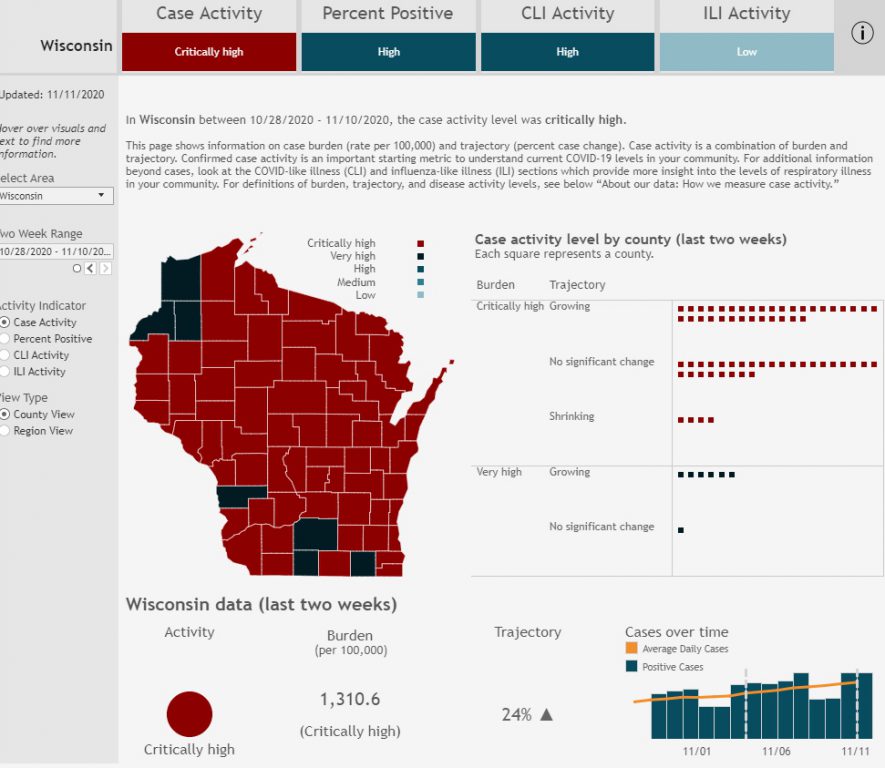65 Counties Have “Critically High” COVID-19 Levels
State unveils new designation, and for the second time has a new way to say COVID-19 is at dangerous and growing levels.
In June the Wisconsin Department of Health Services unveiled its weekly activity level report. The report attempts to cut through the noise and give a clear understanding of the two-week caseload — the truly active cases — in any of the state’s 72 counties.
The initial system had three levels: low, medium and high. Counties were placed in the categories based on their per-capita caseloads. The high level was set at a threshold of 100 cases per 100,000 residents.
Now comes the “critically high” designation with a threshold 1,000 cases per 100,000 residents. The state unveiled the designation Wednesday as part of its weekly updated. Sixty-five of the state’s counties qualify.
The state average rose to 1,310.6 cases per 100,000 residents, an increase of 24% over last week’s measurement.
In the past 14-days, 75,765 Wisconsin residents have tested positive. The two-week total exceeds that of the state’s entire count from March through the end of August, 181 days.
“To put these new data in perspective, Wisconsin is now seeing more average cases per day than New York City did at the peak of its surge last spring,” said DHS Deputy Secretary Julie Willems Van Dijk in a press release. “Because of these critically high levels of disease, public health can no longer adequately contact trace, hospital beds are filled with patients with COVID-19, and too many Wisconsin families are losing loved ones to this virus. By helping people see the critically high level of disease in their counties and regions, we hope these data enhancements will help people make important decisions to stay home in order to stop the spread of COVID-19.”
Milwaukee County’s two-week rate stands at 1,215.5 cases per 100,000 residents, a record high. But the county’s all-time ranking has fallen from first to 19th since September and is on track to continue to fall. Thirty-three counties have critically high designations and show a growing spread (including Milwaukee).
The county with the highest current two-week rate, 2,966.7, also leads the state over the length of the outbreak with an all-time rate nearing 10,000.
The county with the lowest rate, Washburn County (769.6) in northwestern Wisconsin, has a growing rate. Only Green County is in the lower “very high” category and does not have a statistically-significant growing rate.
You can interact with the dashboard on the DHS website.
You can see more on cases, hospitalizations and deaths in our daily data-driven COVID-19 report.
If you think stories like this are important, become a member of Urban Milwaukee and help support real, independent journalism. Plus you get some cool added benefits.
More about the Coronavirus Pandemic
- Governors Tony Evers, JB Pritzker, Tim Walz, and Gretchen Whitmer Issue a Joint Statement Concerning Reports that Donald Trump Gave Russian Dictator Putin American COVID-19 Supplies - Gov. Tony Evers - Oct 11th, 2024
- MHD Release: Milwaukee Health Department Launches COVID-19 Wastewater Testing Dashboard - City of Milwaukee Health Department - Jan 23rd, 2024
- Milwaukee County Announces New Policies Related to COVID-19 Pandemic - David Crowley - May 9th, 2023
- DHS Details End of Emergency COVID-19 Response - Wisconsin Department of Health Services - Apr 26th, 2023
- Milwaukee Health Department Announces Upcoming Changes to COVID-19 Services - City of Milwaukee Health Department - Mar 17th, 2023
- Fitzgerald Applauds Passage of COVID-19 Origin Act - U.S. Rep. Scott Fitzgerald - Mar 10th, 2023
- DHS Expands Free COVID-19 Testing Program - Wisconsin Department of Health Services - Feb 10th, 2023
- MKE County: COVID-19 Hospitalizations Rising - Graham Kilmer - Jan 16th, 2023
- Not Enough Getting Bivalent Booster Shots, State Health Officials Warn - Gaby Vinick - Dec 26th, 2022
- Nearly All Wisconsinites Age 6 Months and Older Now Eligible for Updated COVID-19 Vaccine - Wisconsin Department of Health Services - Dec 15th, 2022
Read more about Coronavirus Pandemic here






















